Q&A – Ask Neil: June 15, 2023
(Please read these instructions carefully.)
Before you post your question, please look at recent issues to see if someone else has already asked it. You might find your answer there.
How to submit your question…
- Click the link provided below to post your question. After you submit your question, a new window will pop up giving you the address to which you can e-mail a sharp, high-resolution photo to accompany your question. Please do not send thumbnail photos in case I need to zoom in to see things.
- Click here to post your question.
- Please only post your question one time. We can only accept a set number of questions each week, and when we get duplicates it costs other people their chances.
- One question per reader, please.
- Please use this only for posting questions – not for standard emails.
- Watch for your answer in the following week’s e-gardens.
- I choose those of greatest general interest. For example, plant IDs seldom make the cut.
- I must have your first name or initials.
- I must have your city or county. (Texas is a very large state.)
QUESTION 1
CAN I PROPAGATE BLEEDING HEART FROM CUTTINGS?
Question: Can I propagate bleeding heart from cuttings? Cindy P., San Antonio.
Answer: If you’re talking about the northern garden perennial Dicentra spectabilis that is common in colder climates but seldom seen in hot old Texas, it is propagated by division or seed according to this information from the University of Wisconsin (where I also borrowed this photo).

If you’re talking about the tropical bleeding heart vine (Clerodendrum thomsoniae), it definitely is started from cuttings. I’ll just stick with the University of Wisconsin for information and their photo.

QUESTION 2
HOW CAN I KILL THISTLES?
Question: What can I use to kill thistle weeds (with the purple blooms)? They are taking over 1-1/2 acres of pasture. When should it be done? Gary L., Weatherford.
Answer: Keep it mowed so it can’t bloom and go to seed. (Probably too late for this year.) Late next winter or very early next spring, spray the rosettes of the plants with a broadleafed weedkiller. It sounds like you may need a good bit, and that may require registration with the state (out of my field of expertise). Talk to your county Extension office or a feed store. That’s probably where you’ll end up buying it anyway.
QUESTION 3
WHY HAS MY BLOODGOOD MAPLE SUDDENLY DIED BACK?
Question: My 15-year-old Bloodgood Japanese maple has suddenly declined this year after leafing out. Leaves on several of the top limbs have died, while new leaves have sprouted farther down near the trunk. It looked fine last year. Red sandy soil. Sharron R., Grapevine.
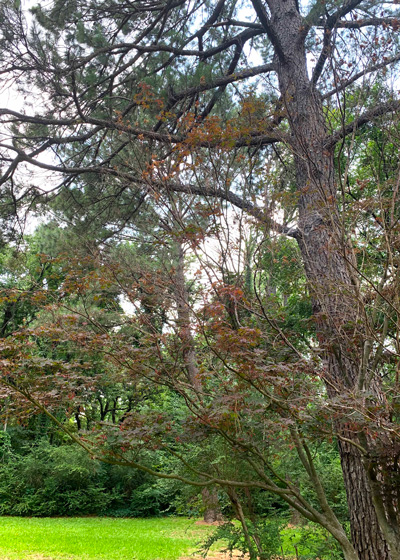
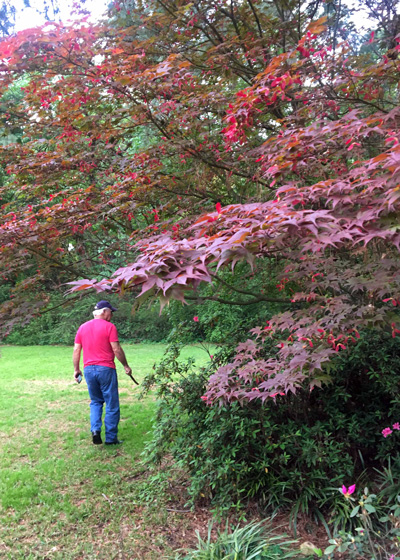
Answer: You’re not alone. I’ve been asked this 8-10 times this spring. Several of them looked like they hadn’t been kept moist enough during last summer’s record heat and drought. One or two may have been visited by borers in their trunks. That’s an easy confirmation. If part of the tree has to be taken down, check for borer tunnels in the wood. Usually, however, borers move into Japanese maples that have been weakened by other problems (such as drought). The prior two winters did not cause the problem. Japanese maples are among our most cold-hardy trees. My suggestion would be that you look very closely at the trunk just above the points of dieback. If you have healthy growth at some point and dead wood above it, the problem has to be somewhere there in the interface. Unfortunately, without seeing the tree better that’s as close as I can come.
QUESTION 4
IF I REPLANT MY ST. AUGUSTINE WILL IT CATCH THE SAME FUNGUS THAT KILLED THE ORIGINAL GRASS?
Question: My St. Augustine was destroyed by fungus. I used Azoxystrobin on it. If I replant now will the new grass become infected, too? It started yellowing last fall and failed to green up this spring. What are your thoughts about zoysia and its varieties? Christine G., Bedford.
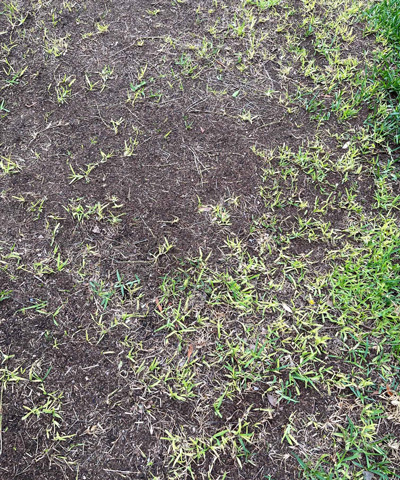
Answer: I see what I think might be take all root rot on the grass in your photo. It causes yellowed patches of grass in an otherwise healthy lawn. Affected runners pull up easily because the roots have been attacked. But it’s primarily a spring disease, plus it normally doesn’t do this thorough a job of killing the St. Augustine in one spring. Therefore, I wonder if you had chinch bug damage late last summer that may have gone undetected. Replant now, but watch the new grass in the hottest, sunniest areas. As the grass dries this summer, if watering doesn’t correct the signs of dry turf, look closely for chinch bugs. They’re BB-sized black insects with irregular white diamonds on their wings. Imidacloprid will stop them.
As for the zoysias, they are also impacted by many of the same insects and diseases as St. Augustine, so you can’t get away from them by switching grasses.
QUESTION 5
WHEN AND HOW FAR BACK DO I TRIM MY MUMS FOR A GOOD FALL BLOOM?
Question: The mums I planted a few years ago are doing well. How far back should I cut them for a really good fall bloom, and when should it be done? Paul T., Temple.
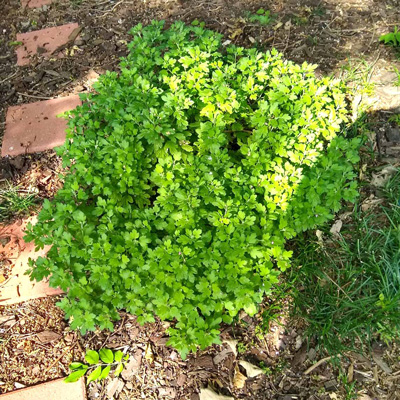
Answer: The best time to pinch mums back is late April into late May. That gives them ample time to send out new shoots before they start setting buds. That said, your plants look like they’re still fairly compact so you may be able to get by with a light tip prune.
QUESTION 6
WHAT DO I DO WITH A SCHEFFLERA THAT IS BECOMING LANKY?
Question: I have a schefflera from my brother’s funeral. The plant is growing upward with great vigor. As it grows taller it loses bottom leaves. It has approximately 24 inches of bare stalks now. Do I need to cut the stalks and replant them? Bobby L., Bryan.
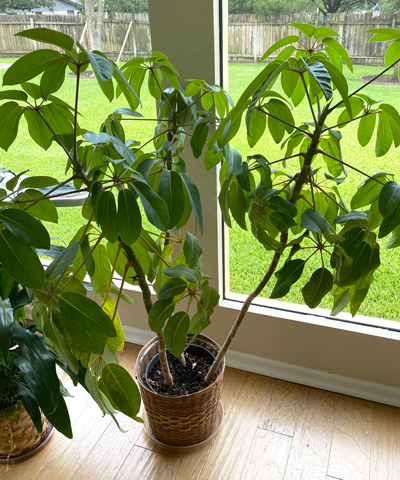
Answer: No. The severed tops would not survive without roots to support them. You’re doing well with your plant. It’s much more common that I’m shown scheffleras with cupped leaves due to insufficient light. Still, that’s what the lower leaf drop is telling you. It needs more direct sunlight early or late in the day.
What surprises many gardeners is that scheffleras are huge trees in their native homes – and even in tropical parts of the U.S. They’re native to northern Australia, Java, and Southern New Guinea. They can grow to 50 ft. tall.
Your plant needs to be repotted. You’ll be called on to repeat that several more times as it grows. At some point, assuming it’s still vigorous, you may decide to cut it back to 24 to 30 inches and let it branch out and start growing over again. It doesn’t appear to be in need of that yet, however.
QUESTION 7
WHAT DO I NEED TO DO WITH MY PEONY THAT HAS MUTATED INTO A MAGENTA FLOWER?
Question: About 10 years ago I purchased three peony plants (don’t know the variety). I have divided them twice over the years and now have 12 plants. One of them has mutated in a few petals. At one point half of the petals were white and the other half magenta. This year one was entirely magenta. I can only imagine this happened somewhere in the pollination, but I can’t figure it out. Do I need to discard this odd plant? Erin S., Mansfield.
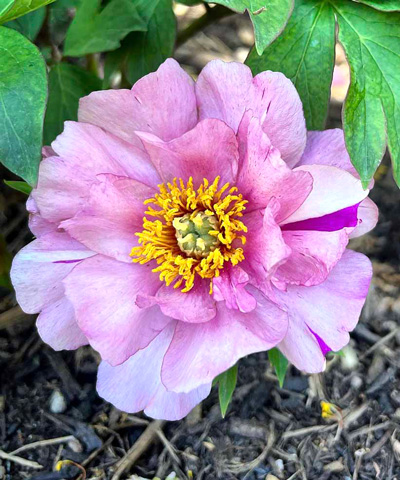
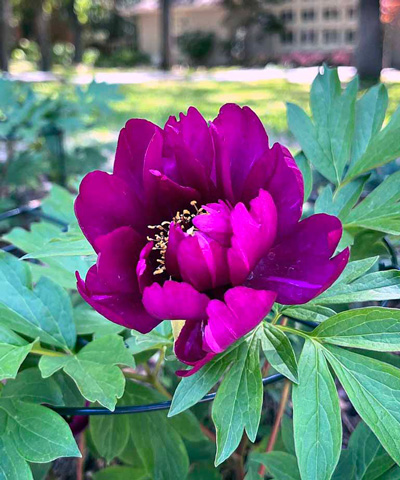
Answer: This is called a chimera. Google that word and the other key word “plants” and you’ll see dozens of examples. Enjoy the novelty of your peony. Goodness. In Texas, enjoy the fact that you can grow any peonies at all! You’re doing better than most of us.
Other examples of chimeras…


QUESTION 8
DO PANSIES LEAVE A FUNGUS BEHIND THAT WOULD ATTACK IMPATIENS?
Question: For the past two years I have planted violas or pansies in November and replaced them with impatiens in April. The impatiens have not thrived. Could the pansies have left a fungus that would have affected the impatiens? Previous impatiens plantings have done well. Karen M., Denton.
Answer: I doubt it. Just as what attacks dogs won’t usually bother donkeys, pansies and impatiens share very few disease problems. Impatiens struggle with hot weather (like last summer’s terrible heat wave), spider mites (made worse by hot, dry weather) and a disease called downy mildew. I have the best luck in shade and part shade with the newer coleus selections, also my favorites, wax begonias and Dragon Wing begonias. When I use impatiens in large patio pots I know that I may be replacing them by mid-summer and I’m fine with that.
QUESTION 9
WHAT ARE THESE KNOBBY GROWTHS ON MY LOROPETALUMS?
Question: What are these knobby-looking growths on my loropetalums? Debbie R., Heath, Rockwall County.
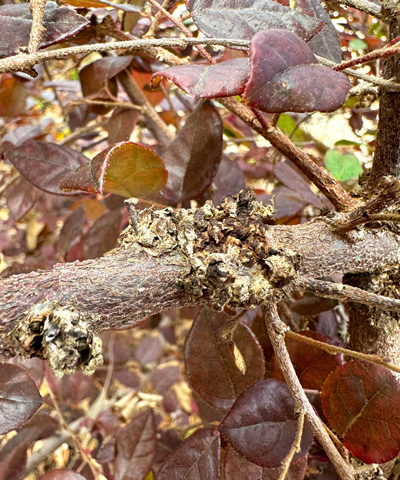
Answer: You could have the Plant Disease Diagnostic Clinic at Texas A&M confirm the identification, but it certainly looks like the bacterial gall shown on this web page from Clemson University. When I Googled “Crown gall Loropetalum” it took me directly to this information. https://hgic.clemson.edu/bacterial-gall-of-loropetalum/ If you feel this is what has infested your plants, you can see that the only means of dealing with it is to remove the entire plant in each case. There is no means of controlling or preventing it.
QUESTION 10
WHAT IS WRONG WITH MY RED OAK TREE?
Question: Attached are photos of my red oak tree. Notice that the leaves are turning yellow and dying. I’ve been told this could be potassium or iron deficiency. I buried 13-13-13 in holes around the tree. Joe W., Weatherford.
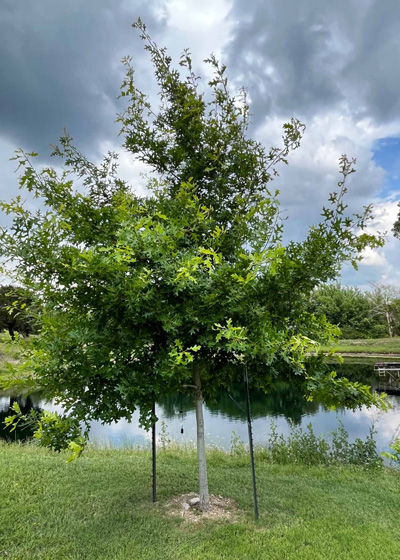
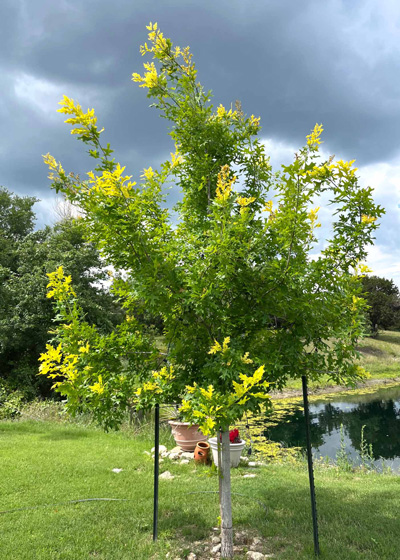
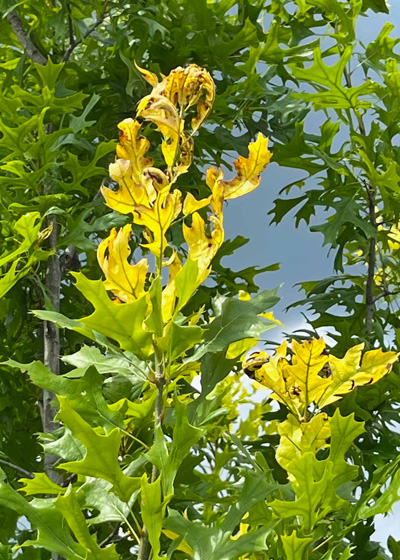
Answer: This is not a Shumard red oak, but some other species that is not adapted to the alkaline soils and irrigation water of Parker County. Unfortunately, I see this all too frequently as nurseries bring in what they are told are Shumards from other parts of the country. These trees are well suited to acidic soils, but they run out of steam after 8 or 10 years in the western two-thirds of Texas. Symptoms of iron deficiency (see how many match your tree): yellowed leaves with dark green veins displaying most prominently on the newest growth first.
And, the critical part of my answer: Trying to correct iron deficiency in a large tree species by applying iron or soil acidifier is a losing battle. It only buys you additional months or maybe a year or two. The tree needs more iron the next year and more the next. Eventually it costs so much that you give up. Plus, it’s less and less effective with the passing time. It’s time to replace.
